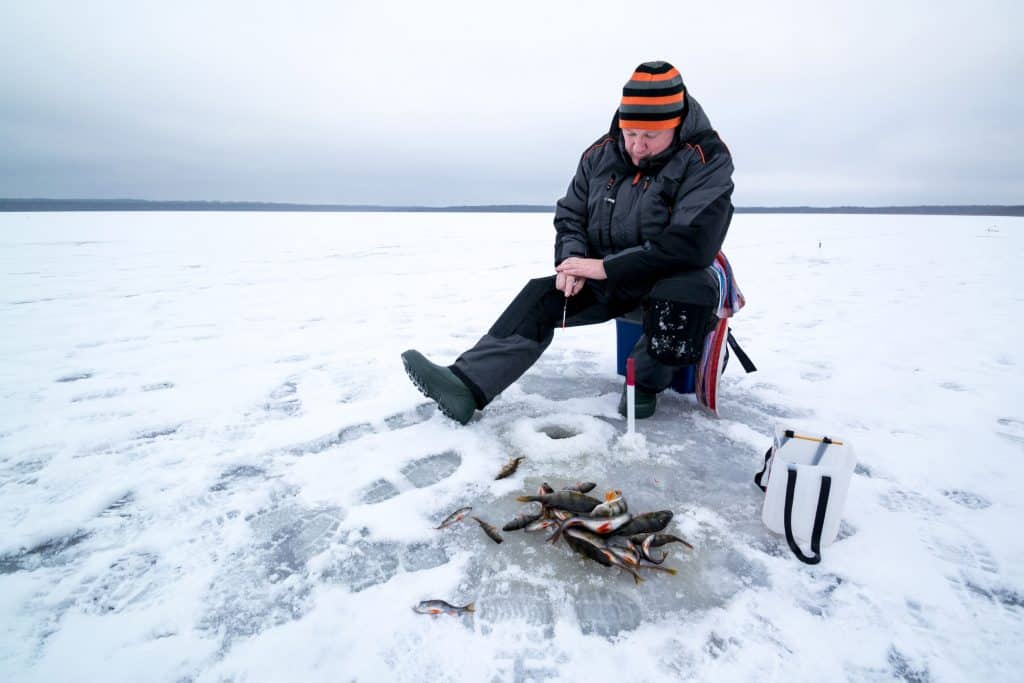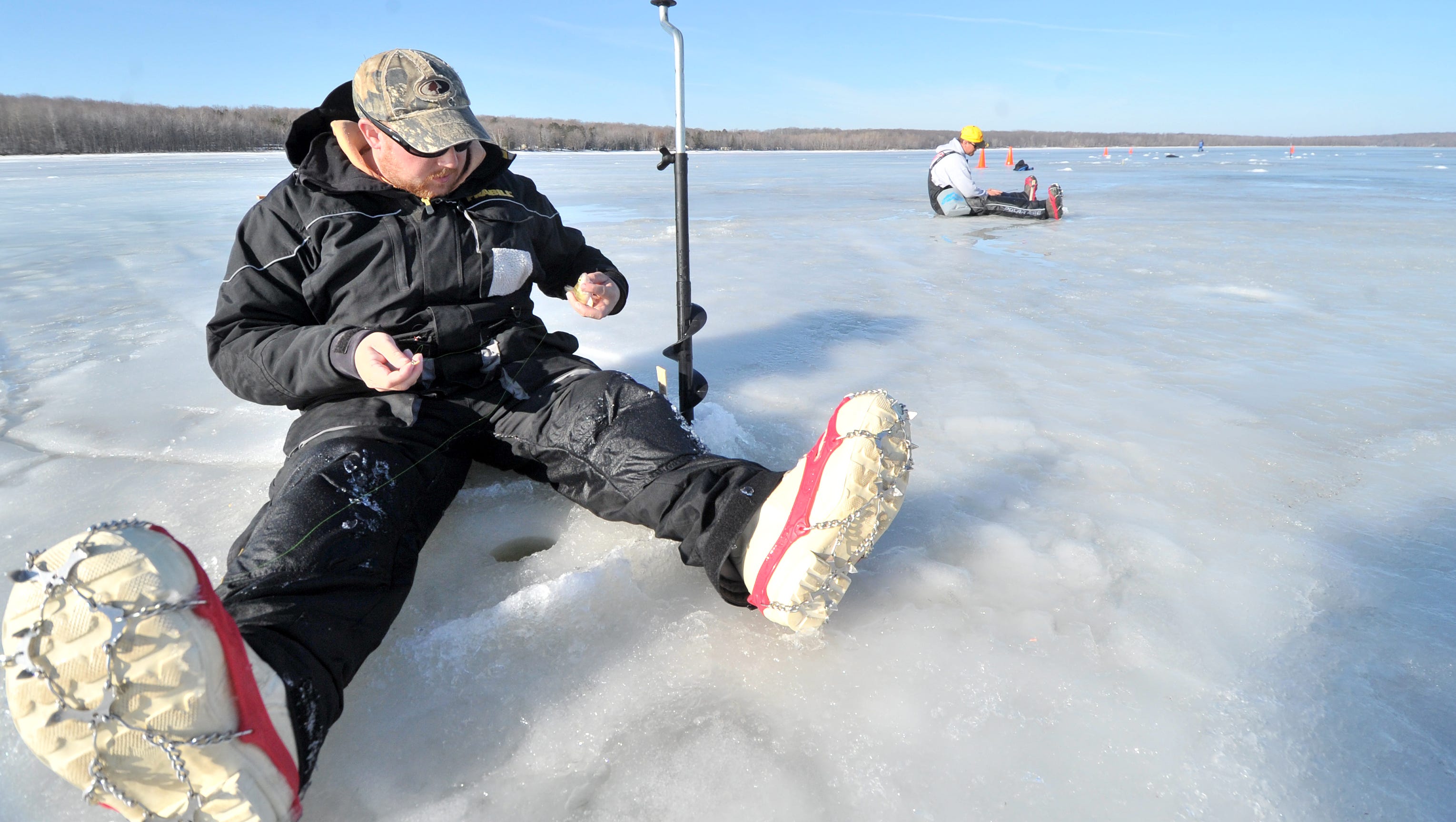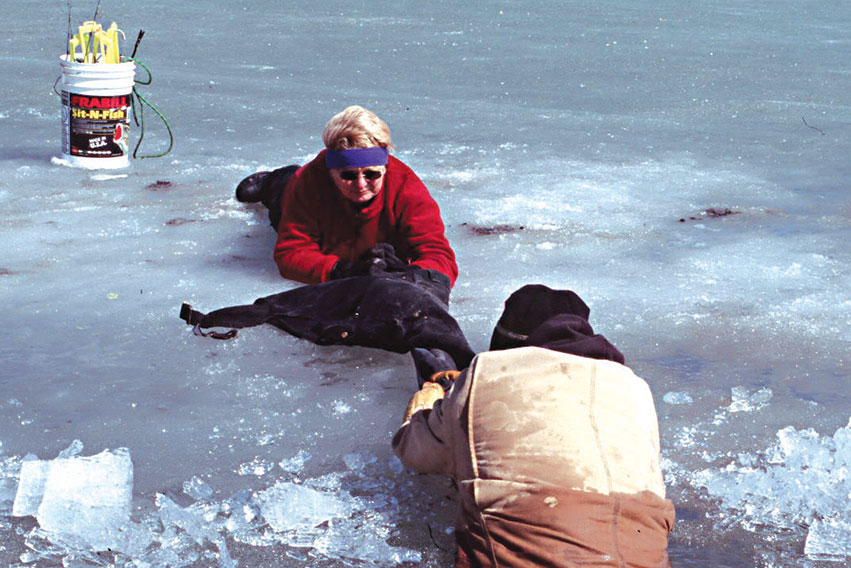Fishing on thin ice can be an exhilarating experience, but it also comes with a lot of risks. With the right preparation and safety measures in place, however, you can bring home some amazing catches while also avoiding treacherous mishaps. In this blog post, we’ll share tips and tricks to help you fish safely on thin ice and provide advice so that you can make the most out of your angling adventure. So grab your fishing gear and read on to learn how to get started safely!
Contents
- 1 Understand the signs of thin ice
- 2 What is Considered Thin Ice?
- 3 General Ice and Cold Water Safety
- 4 Carry the right gear
- 5 Fish with a partner
- 6 Use a spud bar to check the ice thickness
- 7 Be aware of your surroundings
- 8 Listen to your gut
- 9 Stay away from slush
- 10 Know what to do if you fall through the ice
- 11 What To Do If Someone Falls Through Ice
- 12 What to do if an animal is on thin ice
- 13 Ice fishing techniques
- 14 When Fishing On Thin Ice Tips:
- 15 Ice safety tips
- 16 Conclusion
Understand the signs of thin ice
To ensure your safety while fishing on thin ice, you must be able to recognize the signs that the ice is not thick enough. Look for areas with water ripples or bubbles; these are tell-tale signs of thin ice. Also, look out for snow buildup on the ice, as this can often indicate that it’s too thin and unsafe to fish on. Additionally, try to avoid new ice and opt for areas where the ice has been tested already.
What is Considered Thin Ice?
Before heading out onto an icy body of water, the Department of Energy and Environmental Affairs recommends taking multiple measurements to determine if it is safe. The following table outlines their recommended ice thickness for various activities:
- 2 inches thick or less should be avoided completely
- 4 inches or more is considered safe for ice fishing or other activities on foot
- 5 inches is recommended for snowmobiles or ATVs
- 8 to 12 inches is necessary for a small car
- 12 to 15 inches of ice is necessary for trucks

General Ice and Cold Water Safety
Before you head out, make sure to wear plenty of layers and avoid cotton clothing, as it can absorb water if you fall through the ice. Additionally, it is important to bring a buddy and always fish with a partner; this will ensure that someone is there in case something goes wrong. Furthermore, it is essential to carry safety equipment like an ice pick or spud bar to test the thickness of the ice as you go. Finally, stay away from any areas with cracks or pressure ridges and be aware of changing weather conditions; these factors can cause ice to weaken and become extremely dangerous.
Related Articles: 5 Best Chair for Ice Fishing In 2023
Carry the right gear
In addition to safety equipment, make sure you have the right gear and supplies for your fishing adventure. Bring a sled or sled cart to transport your gear more easily; this will also help you keep your hands free in case of an emergency. Make sure to bring the right lures and bait for where you’ll be fishing and have multiple rods set up for different types of fish. Additionally, it is important to carry a life vest with you and wear it when out on the ice in case something goes wrong.
Finally, be mindful of conservation regulations when fishing on thin ice. These regulations can vary from state to state, so make sure that you are familiar with them before heading out and abide by them once you arrive at your destination.
As temperatures drop, so does the safety of venturing out onto icy surfaces. To ensure a safe journey across frozen waters, it’s important to be aware of several key factors such as ice age and the presence of snow or slush. Never go alone—bring along a friend who can assist should you fall through; keep pets on leashes at all times in case they do get lost among the watery depths; stay away from newly-formed crystals for maximum support; watch for signs that snow may cover weak spots within the ice layer and never risk walking over areas with visible slush – these signals decay directly below your feet! Finally, know when crossing riverbanks and lake beds containing an abundance of springs that your footing could potentially give way 15% faster than usual due to rapid thawing underneath.
Ice’s constantly changing environment causes it to form in diverse shapes and depths. A mere 10 feet can create a variance of over 3 inches, making the freezing point unpredictable yet fascinating!
Related Articles: Best Tips And Techniques For Ice Fishing
Fish with a partner
Fishing on thin ice can be an exciting and rewarding experience, but it must also be done with caution. Follow the tips outlined in this blog post to ensure you stay safe while out fishing and make sure that you always have a partner by your side to watch out for any dangers. With the right preparation and safety measures in place, you can bring home some amazing catches while avoiding treacherous mishaps. So grab your gear, bring along a buddy, and get ready for an unforgettable angling adventure!

Use a spud bar to check the ice thickness
It is important to use a spud bar or ice chisel when ice fishing on thin ice. This will help you identify any weak spots in the ice and make sure you stay far away from them. Additionally, it can also be used to test for the thickness of the ice; this should be done every few feet as you move around on the frozen surface. If the ice is less than four inches thick, it should be avoided completely. For snowmobiles and ATVs, five inches of thickness is recommended and eight to twelve inches are necessary for a small car while twelve to fifteen inches are necessary for trucks.
Be aware of your surroundings
Be aware of any changes in weather or ice conditions while out fishing on thin ice. Ice can become much more dangerous if the temperature rises, causing it to weaken and crack. If you notice areas with noticeable pressure ridges or cracks, steer clear! Additionally, pay attention to your surroundings – keep an eye out for small bodies of open water near edges as this can be a sign that the ice has been weakened by large animals venturing across.
Related Articles: Damn Good Tips And Tricks Ice Fishing for Catching a Walleye
Listen to your gut
If something doesn’t feel right while fishing on thin ice, listen to your instinct and leave the area immediately. Even experienced anglers can get into dangerous situations, so being able to recognize when it is time to turn back is crucial for staying safe. Make sure you have a plan for getting off the ice should an emergency occur, and always keep a charged cell phone with you in case of an emergency.

Stay away from slush
Slush is one of the most dangerous conditions to encounter when fishing on thin ice. This occurs when there is an area of open water that has been frozen over by a thin layer of ice, usually due to snow melt or rain. Slush layers are incredibly weak and can easily collapse under your weight, so it’s best to stay far away! Additionally, be aware of any current flowing beneath the surface – this can also create large areas of unstable ice that could give way at any moment.
Related Articles: 5 Best Ice Fishing Boots For Men In 2022
Know what to do if you fall through the ice
If you do find yourself in a precarious situation where the ice is too thin, try to remain calm and move slowly. It’s important not to thrash around as this could cause further breakage. Instead, spread your arms out and kick your legs gently while staying flat on the ice surface. This should help create enough resistance that allows you to eventually get back onto solid ground. Once there, crawl away from the area of open water and keep your clothes and body warm until help arrives.
Fishing on thin ice can be an exciting adventure but it comes with some risks if proper safety measures aren’t taken beforehand. Make sure you’re aware of your surroundings and always have a partner by your side to watch out for any potential dangers. With the right preparation and knowledge, you’ll be able to stay safe while out fishing on thin ice, bringing home some amazing catches along the way!
What To Do If Someone Falls Through Ice
If you or someone else falls through the ice while fishing, it is important to remain calm and take action quickly. The first step should be for whoever is closest to the person who fell in to call 911 if necessary, as well as alert anyone else on the lake who can help. It’s also important to make sure that no one else goes onto the ice — even if they think they can help.
Once emergency services have been alerted, it’s important to try to get the victim out of the water as soon as possible. This means throwing a rope or other buoyant object (such as a life jacket) within reach of them so they can grab hold and be pulled back onto safe ice. If the victim is too far away, making a rescue line out of several strong sticks and ropes can also be used to help pull them in.
If you find yourself alone on the lake when someone falls through the ice, use items like a branch or ski pole to reach out and try to get them back onto safe ice. If that isn’t an option, another alternative could be to create an extension ladder with long poles so they can climb out on their own.
Above all else, stay as calm as possible and do what you can until emergency services arrive or other help arrives. The quicker the person is taken out of the cold water, the better chance they have at survival!
Related Articles: How To Choose The Best Ice Fishing Gloves
What to do if an animal is on thin ice
If you come across an animal, such as a deer or beaver, that is on thin ice, the best thing to do is call your local wildlife officer. They will be able to assess the situation and act quickly if they need to rescue the animal.
In some cases, it may be possible for you to assist safely. If this is so, use items like branches or ski poles as a makeshift extension ladder or ramp so the animal can make its way off the ice safely. However, remember not to put yourself at risk for their sake — never go onto thin ice!
It’s also important to avoid crowding around the animal too much, as this can startle them and possibly make them fall through the ice. Instead, stay back and observe from a safe distance until help arrives to provide the best chance of a successful rescue.
Fishing on thin ice can be a thrilling experience but it also comes with some risks. Be prepared ahead of time so you stay as safe as possible while out fishing, and know what to do if someone or an animal falls through the ice. With these precautions in mind, you’ll be able to enjoy your fishing trip worry-free! Good luck and happy fishing!

Ice fishing techniques
Ice fishing can be a rewarding experience but it requires some knowledge and preparation to get the most out of your trip. Once you’re out on the ice, there are several techniques you can use to land more fish.
For starters, make sure to always check the depth of water beneath the ice and adjust your bait or lure accordingly. You should also move around the area regularly to find the best spots for catching fish.
When drilling holes into the ice, use an auger or spud bar and try to keep them all at least ten feet apart from each other — this ensures you don’t frighten away any nearby fish as they will be more likely to swim away if they sense danger.
You can also use flashers, sonar devices, and underwater cameras to help you locate fish hiding beneath the ice. These tools are invaluable for finding out where the best fishing spots are located within an area.
Finally, remember that ice fishing requires patience and a lot of practice. By learning different techniques and doing some research on the type of fish in your area, you’ll be able to make each trip more successful! Good luck and happy fishing!
Related Articles: Best Ice Fishing Suits (Top Product Reviews 2022)
When Fishing On Thin Ice Tips:
Fishing on thin ice is inherently dangerous, so it’s important to take safety precautions before heading out onto the lake. Wear several layers of clothing (including a waterproof outer layer) and proper ice fishing boots to keep your feet insulated and dry. It’s also important to bring a life jacket or flotation device in case someone falls through the ice.
Check the conditions of the lake before you go, including water levels and ice thickness. If there are less than 4 inches of thick hard-packed snow on top of the ice, it should be avoided at all costs. Wear a safety rope attached around your waist that can be released quickly if necessary — this will help you stay safe and secure while out on the lake.
Bring along a few essential items such as spare clothing, food, water, matches or a lighter, and a first aid kit. Lastly, when choosing an area to set up, look for areas with well-established ice roads or trails as these are usually more stable and safe. With these tips in mind, you’ll be able to stay safe while fishing on thin ice!
Ice safety tips
In addition to knowing what to do in the event of an emergency, it’s also important to take some safety precautions when fishing on thin ice. Before you head out onto the lake, check with your local fisheries office to find out their recommended ice thickness and read up on any additional safety tips they may have.
Be sure to always wear a personal flotation device (PFD) — even if you are a strong swimmer — and bring along a whistle or other sound-making device so that help can be summoned quickly in case of an emergency. It’s also a good idea to let someone else know where you will be going and how long you expect to stay there so that they can alert authorities if need be.
Finally, avoid drinking alcohol while on the ice as this can drastically reduce your reaction time and put you at greater risk of falling through the ice. Taking these precautions will help ensure a safe and enjoyable ice fishing experience!
Related Articles: How To Choose Ice Fishing Boots For Women
Conclusion
Fishing on thin ice can be dangerous but following these simple tips will help you stay safe while enjoying the sport. Make sure to always check the thickness of the ice before venturing out, and never go alone. Wear proper clothing and equipment, and carry a safety kit with you in case of an emergency. By following these simple tips, you can safely enjoy fishing on thin ice all winter long!







